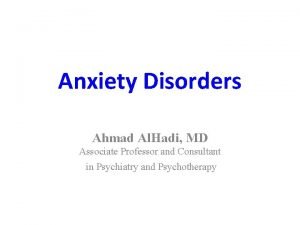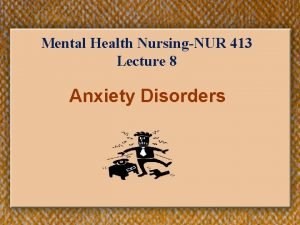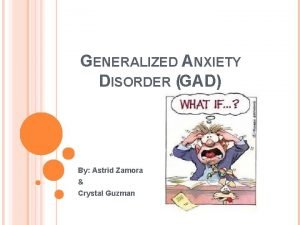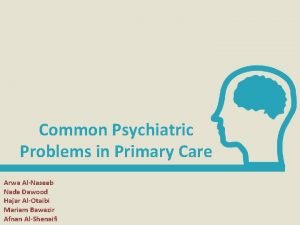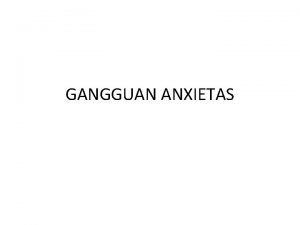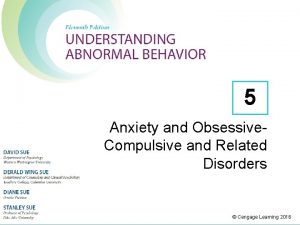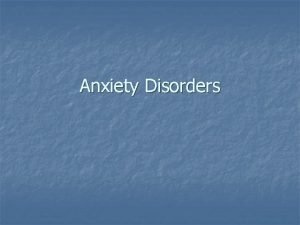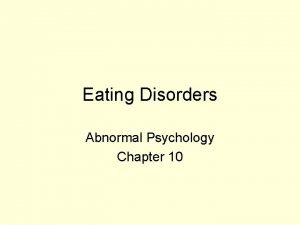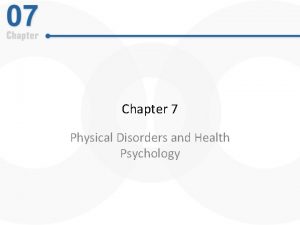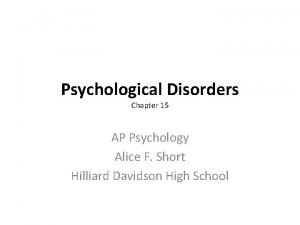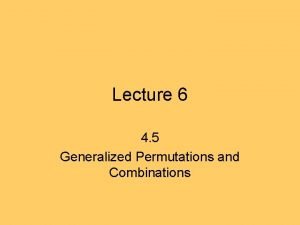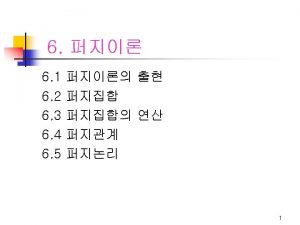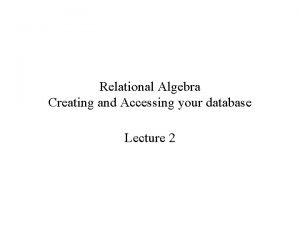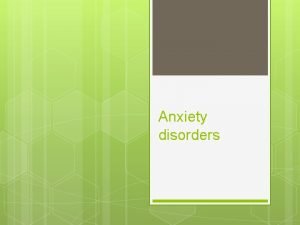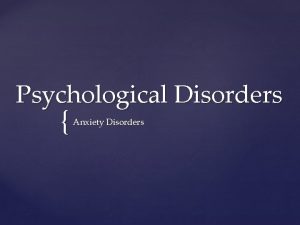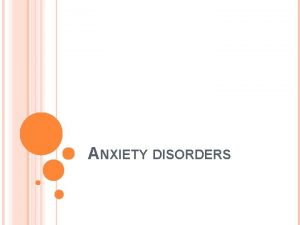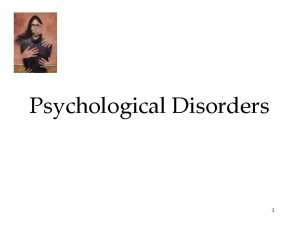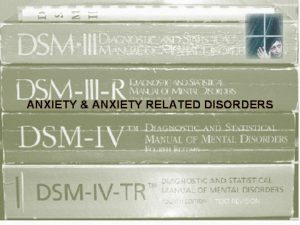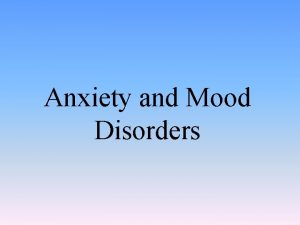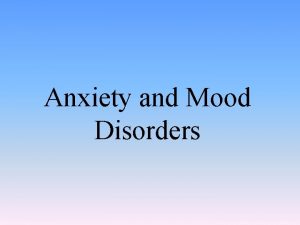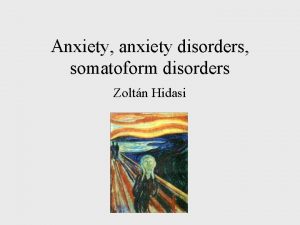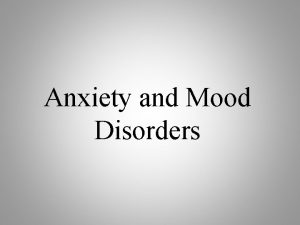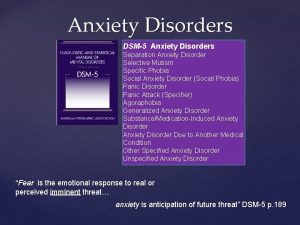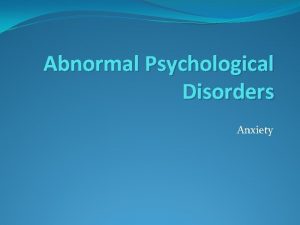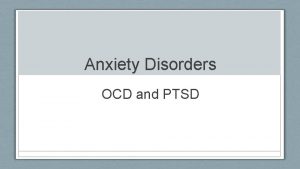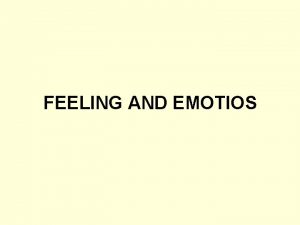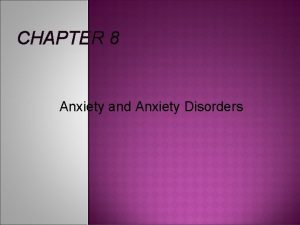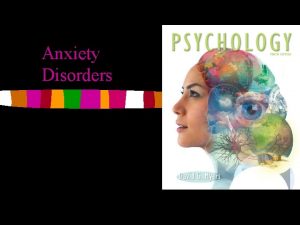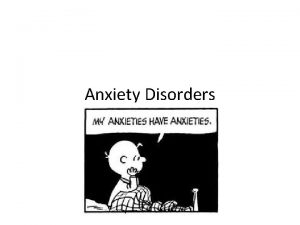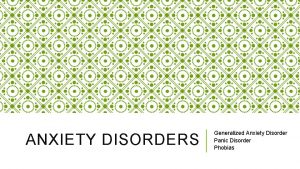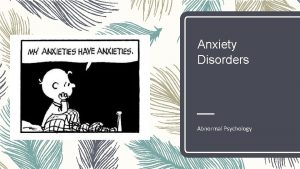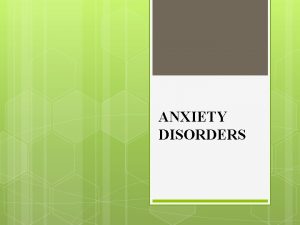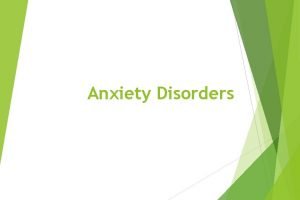Anxiety Disorders AP Psychology Anxiety A generalized feeling























- Slides: 23

Anxiety Disorders AP Psychology

Anxiety • A generalized feeling of apprehension and dread that includes many bodily upsets.

Panic Attacks • Can occur in the context of any A. D as well as other mental disorders. • Discrete period of intense fear or discomfort in the absence of real danger • Somatic or cognitive • Sweating, trembling, chest pain, sensations of shortness of breath, dizziness, fear of losing control. • Attacks peak at 10 minutes.

Diagnosis w/ any type of Anxiety Disorder… Maladaptive • a person must have the following 3 distinct characteristics: 1. Uncontrollable: can not shut off the “alarm system” 2. Disruptive 3. Anxiety is out of proportion to the actual danger or threat imposed by the situation.

Generalized Anxiety Disorder • An excessive or unrealistic worry about life circumstances that last for at least six months. • “free floating anxiety” • Typical worries focus on finances, employment, interpersonal problems, accidents, or illness.

Diagnostic criteria • 6 months • Difficult to control the worry • At least three or more are present: restlessness/on edge being easily fatigued difficulty concentrating irritability muscle tension sleep disturbance

GAD • Most common anxiety disorder • Few people seek treatment • Children can also be diagnose with this disorder • Many people with GAD also have other anxiety disorders.

Panic Disorder • Characterized by frequent and overwhelming attacks of anxiety that are not associated with specific objects or events. • 6 months • Disorder starts b/c something is physically or chemically wrong. • First: Physical occurrence • Soon: Panic spreads • Problem: physical to psychological

Treatment (next chapter) • Biomedical therapies, Behavioral therapies, and Psychotherapy

Phobic Disorders • A person becomes disabled and overwhelmed by fear in the presence of certain objects or events. • Phobia: “fear of “ Two basic types of Phobic Disorders Next slide

1. Specific Phobia • Phobic Disorder associated w/ a specific object or situation. • Ex. Dogs, snakes, elevators, and heights, water, etc. • Faced w/ the phobic stimulus the person becomes extremely anxious. • 6 months

1 a. Social Phobias • This is among the most common phobic disorders. • Irrational fear of normal social events. • Example: “Ted has trouble going to social events because he cannot use the bathroom anywhere except at his own house” (DSM-V, case manual, 2013)

What causes Specific Phobia? • • • Association/ Learning (chapter 6) Remember: UCS UCR CS CR Remember: Stimulus generalization, Stimulus discrimination, extinction, and spontaneous recovery. • “Little Albert” • Operant Conditioning and O. L. • Another theory: Preparedness Hypothesis

Specific Phobia • Treatment (next chapter): systematic desensitization. Biomedical therapies, psychotherapy, and Cognitive behavior therapy

2 nd type of Phobic disorder • Agoraphobia: anxiety about being in places or situations from which escape might be difficult (or embarrassing). • 6 months

Agoraphobia • Avoid: 1. Situations that they think might provoke a panic attack 2. Situations in which they would be unable to escape or get help if they did suffer a P. A. 3. Ex. Crowds, standing in line, elevators, public transp.

Agoraphobia • Many agoraphobics are women. • Most agoraphobics have a specific boundary. Varies from person to person

New disorder • Next disorder: – In the DSM-V, this disorder has received its own chapter, separate from anxiety disorders. – 10 th leading cause of mental disability in the developed countries.

Obsessive-Compulsive Disorder • Obsession refers to an endless preoccupation with some type of urge or thought. • Compulsion is a symbolic, ritualized behavior that a person must repeatedly act out. • !!!each time the person acts out the behavior, the anxiety he/she feels is decreased.

OCD • Characterized by both repetitive thoughts (obsession) and ritualized, repetitive behavior (compulsion). • Most people w/ OCD are “checkers” • Marked distress • Time consuming (one hour or more) • Inefficient performance of cognitive tasks • Avoidance of objects or situations: restrict general functioning.

Explaining OCD • Deficiency in the neurotransmitter serotonin • Medication that increases the availability of serotonin, helps many patients. • Dysfunction in specific brain areas: frontal lobes, caudate nucleus (movements) in OCD the C. N. is overactive. • Defense mechanism: faulty attempts to resolve guilt, anxiety, or insecurity.

Explaining OCD • Learned behavior • Treatment (more details in the next chapter) • Biomedical therapies • Psychotherapy • Behavioral therapy

Anxiety Disorders • The End
 Agoraphobia vs social phobia
Agoraphobia vs social phobia Examples of generalized anxiety disorder
Examples of generalized anxiety disorder Astrid zamora
Astrid zamora Generalized anxiety disorder dsm 5
Generalized anxiety disorder dsm 5 Icd 10 anxietas
Icd 10 anxietas Multipath model of anxiety disorders
Multipath model of anxiety disorders Chapter 15 anxiety and obsessive-compulsive disorders
Chapter 15 anxiety and obsessive-compulsive disorders Anxiety disorders def
Anxiety disorders def Kate moss anorexia
Kate moss anorexia Physical disorders and health psychology
Physical disorders and health psychology Ap psychology chapter 15 psychological disorders
Ap psychology chapter 15 psychological disorders Fundamental attribution error ap psychology
Fundamental attribution error ap psychology Social psychology is the scientific study of
Social psychology is the scientific study of Introspection method in psychology
Introspection method in psychology Positive psychology ap psychology definition
Positive psychology ap psychology definition Health psychology definition ap psychology
Health psychology definition ap psychology Deindividuation
Deindividuation Generalized suffix tree python
Generalized suffix tree python Chapter 3 cells and tissues figure 3-1
Chapter 3 cells and tissues figure 3-1 Generalized permutations and combinations
Generalized permutations and combinations Generalized linear phase
Generalized linear phase Aturan fuzzy
Aturan fuzzy Generalized projection in dbms
Generalized projection in dbms Generalized biogeochemical cycle
Generalized biogeochemical cycle
